Cooked chickpeas ( Cicer arietinum ) are rich in fiber and ideal for all kinds of meatless, quick dishes. Cooked chickpeas ( organic? ) are usually found in cans or preserved in jars.
Use in the kitchen
Raw chickpeas need to be soaked for a few hours and then cooked before they can be eaten. Chickpeas from a can or jar are cooked and can therefore be processed or consumed immediately. The thin, milky skin can be eaten without any problem. If you find it annoying, you can remove it.
Cooked chickpeas are very versatile. They are great warm in vegetarian or vegan stews, curries, dals or soups. They can be enjoyed cold in salads, dips or as antipasti. They also taste wonderful fried with vegetables or made into patties. Chickpeas roasted in the oven and seasoned as desired (e.g. with curry , chili , garlic ) are a delicious snack. Cooked chickpeas can also be used as part of a sauce for pasta or gnocchi. Falafel (fried or baked balls) and hummus (chickpea puree) are well-known and very popular oriental dishes made from chickpeas.
The preparation with anise , fennel seeds , caraway or herbs such as parsley , rosemary , thyme is popular because it increases the digestibility of the chickpea and prevents flatulence.
Unripe green chickpeas can be used in the kitchen in a similar way to green peas.
Recipe for vegan chickpea curry
Ingredients (for 2 people): 1 can of cooked chickpeas (400 g), 1 can of chopped tomatoes (400 g), 1 onion , 1 red bell pepper , 1 tbsp rapeseed oil , 2 tbsp tomato paste , 2 tsp cumin (ground) , 1 tsp curry powder, 1 pinch of chili powder, some salt andpepper , 2 tbsp soy yoghurt .
Preparation: Peel and dice the onion. Wash the sweet peppers and cut into pieces. Heat rapeseed oil in a pan and sauté the onion cubes until translucent. Add the sweet peppers and fry for about 2 minutes. Add the chickpeas and chopped tomatoes and stir well. Add the tomato paste, cumin, curry and chili, stir and simmer over a low heat for about 15 minutes. Season with a little salt and pepper and serve with a dollop of soy yoghurt. Naan bread, basmati rice or couscous go well with the vegan chickpea curry.
Vegan recipes with chickpeas (cooked) can be found under the note: " Recipes that have the most of this ingredient ".
| Not only vegans or vegetarians should read this: Vegans often eat unhealthily. Avoidable nutritional mistakes . |
Purchasing - Storage
Cooked chickpeas can be bought in most supermarkets (e.g. Coop , Migros , Denner , Volg , Spar , Aldi , Lidl , Rewe , Edeka , Hofer , Billa ) and organic supermarkets (e.g. Alnatura , Denn's Biomarkt ), often in organic quality (bio). Health food stores and online shops also offer cooked chickpeas. The cooked chickpeas can be found in cans or jars, preserved in their own cooking liquid and seasoned with salt.
The availability of cooked chickpeas varies depending on the size of the store, catchment area, etc. If you are interested, click on our recorded food prices for the DA-CH countries (above under the ingredient image). There you will find current prices from various supermarkets and their price development.
Storage tips
Cooked chickpeas in a can or jar will last for at least a year if they are stored unopened in a dark place and below 20 °C. In most cases, the contents can be used well beyond the printed best-before date - open the can and let your sense of smell and taste decide. Opened canned chickpeas should be used within about three days. Leftover chickpeas (cooked) should not be stored in the opened can, but rather transferred to a porcelain or plastic container with a lid and stored in the refrigerator.
Ingredients - Nutritional values - Calories
The cooking process reduces some of the nutrient content of chickpeas. The energy content of chickpeas (cooked) is 138 kcal/100g - in comparison: raw chickpeas (uncooked) have 378 kcal/100g. The difference in fiber content between raw and cooked chickpeas is less significant: cooked chickpeas have 9.9 g/100g of fiber, raw chickpeas have 12 g/100g. There is little fat at 1.6 g/100g. 1
Despite the cooking process, cooked chickpeas still contain enough manganese , namely 0.99 mg/100g, which is 49% of the daily requirement. Cooked wholegrain rice (0.97 mg/100g) and edamame (1 mg/100g) have a similar amount. The content is of course much lower than in raw chickpeas, which have 21 mg/100g. 1
The amino acid isoleucine is present at 0.52 g/100g in cooked chickpeas (42% of the daily requirement). Couscous (0.49 g/100g) and oat flakes (0.50 g/100g) contain similar amounts. At 1.5 g/100g, peeled hemp seeds contain almost three times as much isoleucine. 1
The folate content of cooked chickpeas is still 63 µg/100g (32% of the daily requirement). This can be compared with that of green peas (65 µg/100g). Raw chestnuts contain a similar amount at 62 µg/100g, but are not edible raw. Almost 10 times as much of this vitamin can be found in mung beans at 625 µg/100g, although these also lose some of their folate during the cooking process. 1
For information on the health-promoting effects of chickpeas, their use in folk medicine and naturopathy, as well as their side effects, read the ingredient raw chickpeas .
The complete ingredients of chickpeas (cooked), the coverage of the daily requirement and comparison values with other ingredients can be found in our nutrient tables. In the article Nutrients explained you will get a detailed insight into the topic.
Ecological footprint - animal welfare
Pulses such as chickpeas, but also beans, soybeans , lentils and peas are considered a healthy plant-based source of protein due to their high protein content and fiber. They have a better environmental impact than milk and meat products. The ecological CO 2 footprint of canned chickpeas is 1.3 kg CO 2 e/kg, significantly lower than that of, for example, beef (13.6 kg CO 2 e/kg) or cheese (5.7 kg CO 2 e/kg). 6
The production of 1 kg of chickpeas requires 4177 litres of water. However, this figure does not specify whether the chickpeas are raw, dried or canned. Among pulses, the water footprint is lower than that of lentils (5874 litres) or dried beans (5053 litres) and overall significantly lower than the amount of water required to produce 1 kg of meat (15,400 litres). 7.8
Cooked, edible chickpeas can be bought in shops either in jars or cans. The latter are usually made of aluminum or tinplate. The production of aluminum requires a lot of energy and the raw material bauxite, which has to be mined over large areas (including rainforests). In addition, aluminum production produces an intermediate product that is toxic to the environment, so-called red mud (contains iron and titanium oxides). If disposed of improperly, this can cause serious environmental problems. 9 Aluminum can be recycled after use, but this process also requires a lot of energy. 10 However, the same applies to the production and recycling of glass. The weight during transport also has a negative impact. 11 Ideally, chickpeas should be bought dried and prepared yourself; this reduces the amount of carbon emissions.
Ideally, when shopping, you should look for regional , organically grown products. This reduces transport distances and, with products from organic farming, you can be sure that no synthetic pesticides or fertilizers have been used. In addition, pulses are very important in organic farming as part of crop rotation, as they are legumes and use soil bacteria to enrich the soil with nitrogen, which the subsequent crop needs to grow. 12
Worldwide occurrence - cultivation
The origin of the chickpea is probably in an area of what is now southeastern Turkey and neighboring Syria. 2 Chickpeas are cultivated in over 50 countries, but India is the main producer. 3 Chickpea cultivation in Switzerland is still small, but could expand further in the coming years.
Information on the cultivation, harvesting methods and ecological aspects of chickpeas can be found in the article Raw chickpeas .
Further information
The chickpea ( Cicer arietinum ) belongs to the legume family (Fabaceae) and the subfamily of the Faboideae. The chickpea is not closely related to the pea ( Pisum sativum ).
The chickpea is the most widely cultivated legume after the soybean . In Europe, the Kabuli variety of chickpea is particularly well-known, with its large, beige seeds. The second variety, which is also often used in cooking, but more in the Middle East and Southeast Asia, is the Desi variety. This variety has smaller, darker seeds. 4
The German name Kichererbse and the English name Chickpea are probably derived from the Latin name of the genus Cicer . This in turn most likely goes back to the Hebrew word "kikar" (round, plump). 5
Alternative names
Cooked chickpeas can also be found under the spellings chickpeas cooked, chickpeas cooked and cooked chickpeas. Incorrect spellings creep in, such as cooked chick peas, cooked chick peas.
In English, cooked chickpeas are called cooked chickpeas or garbanzo beans. Often, reference is made to the fact that cooked chickpeas are preserved in cans and are therefore called canned chickpeas.
Other uses
The cooking liquid found in canned legumes (such as chickpeas) is called aquafaba . It can be used as a vegan egg white substitute (beaten egg whites) in the preparation of desserts and pastries.

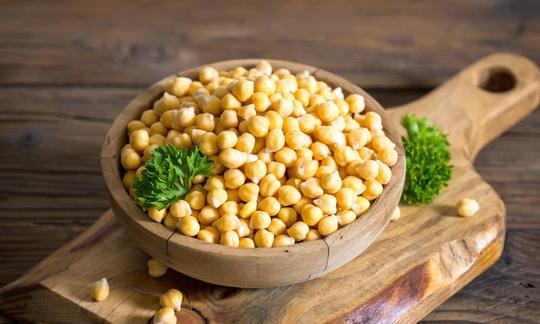

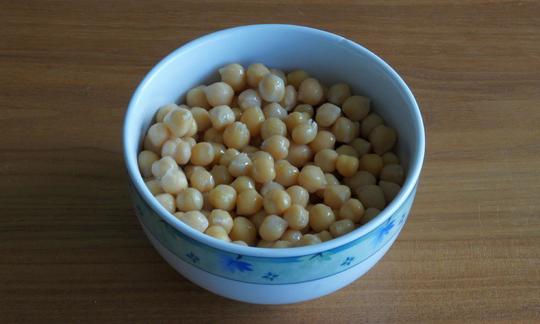

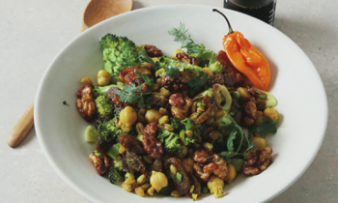
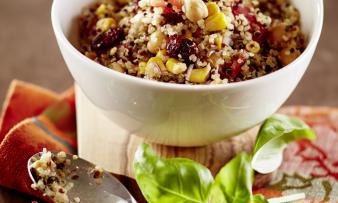
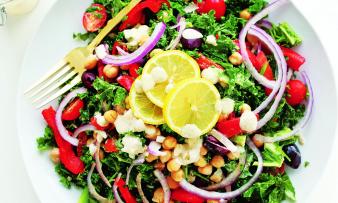





Comments